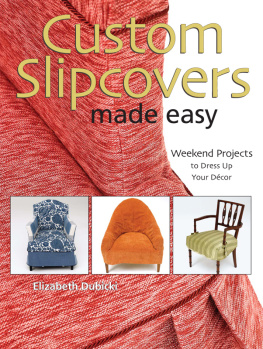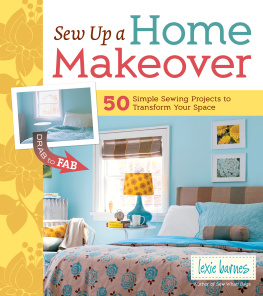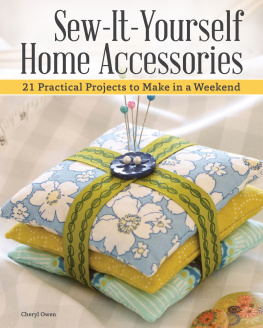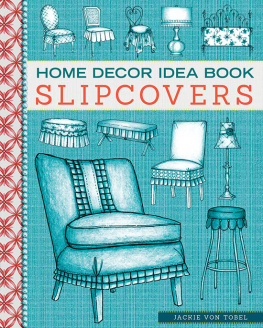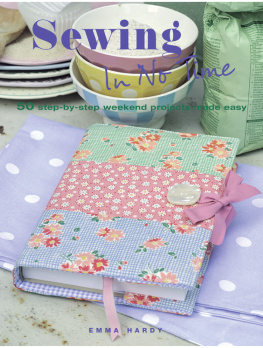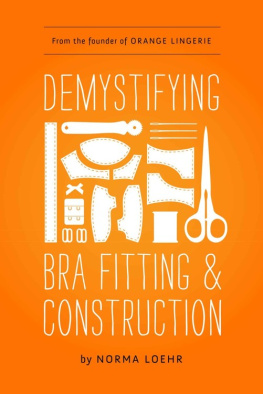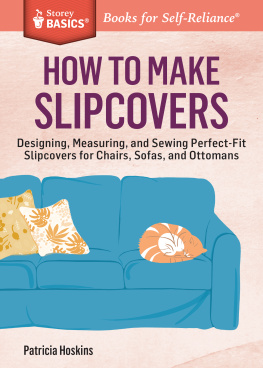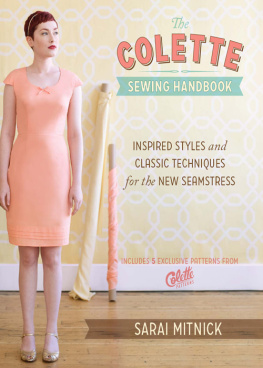Custom
Slipcovers
made easy
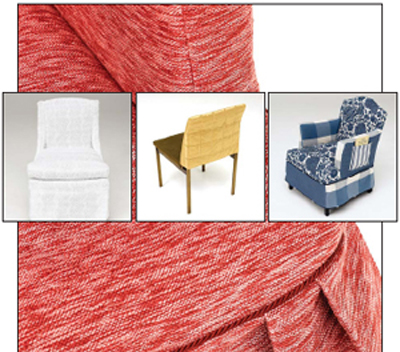
Elizabeth Dubicki
2007 Elizabeth Dubicki
Published by

Our toll-free number to place an order or obtain
a free catalog is (800) 258-0929.
All rights reserved. No portion of this publication may be reproduced or transmitted in any form or by any means, electronic or mechanical, including photocopy, recording, or any information storage and retrieval system, without permission in writing from the publisher, except by a reviewer who may quote brief passages in a critical article or review to be printed in a magazine or newspaper, or electronically transmitted on radio, television, or the Internet.
The following registered trademark terms and companies appear in this publication: Velcro, Waverly, Calico Corners, Wrights and Prym Consumer USA.
Library of Congress Control Number: 2007924846
ISBN-13: 978-0-89689-518-8
eISBN-13: 978-1-4402-2111-8
Designed by Heidi Bittner-Zastrow
Edited by Tracy L. Conradt
Printed in China
Dedication
I dedicate this book to my husband Dave,
with love and gratitude for all of his domestic engineering
during many months of slipcover mania.
Acknowledgments
It was again my pleasure to work with a talented team from Krause Publications: acquisitions editor Candy Wiza; book editor Tracy Conradt; graphic designer Heidi Bittner-Zastrow, and studio photographers Kris Kandler and Robert Best. Thank you all for supporting this project through all phases of production. Kudos, as well, to location photographer Kevin May, and big hugs to my photo stylists and all around slipcover soul mates, Mary Baggott and Ellen Naylor.
Finally, I am very grateful to Waverly, Calico Corners, Wrights and Dritz (Prym Consumer USA) for sending me bolts and bolts of wonderful fabrics and boxes of helpful notions. See the Contributors on page 00 for source information. I urge you to seek out the excellent fabrics and sewing aids offered by these companies. Using their products and services will make your slipcover experiences so much better.
Contents
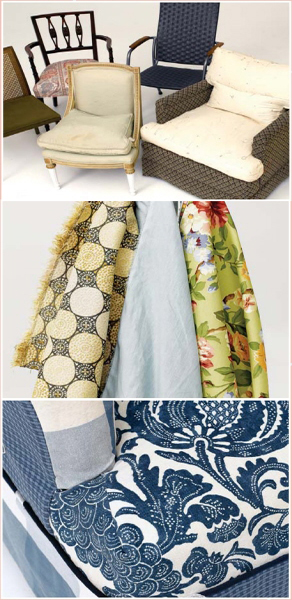
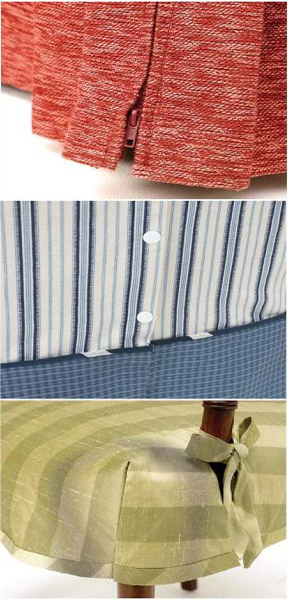
Introduction: A Slipcover Tale
Slipcovers have always played an important role in my mothers decorating strategy and, in fact, have influenced her approach to furniture acquisition. Buy new furniture only when its top-of-the-line and can be purchased at a deep, deep discount, says my mother. Otherwise, you can make do with what you have through repair, repainting or recovering, many times with a slipcover. Inherent in her strategy, too, is the family motto: Never give furniture away to strangersit must be redistributed within the family.
One example of family redistribution involves a large-scale, high-backed, custom-made sofa originally upholstered in soft white wool. This one-of-a-kind piece would have been beyond my parents budget had not the original buyer reneged on the purchase. They picked up this deeply discounted sofa several years before I was born, and it remained a staple in their furniture repertoire for the next 30 years.
White wool isnt practical in a family of growing children, so my mother had the sofa slip-covered in extravagant pink-and-green floral chintz. The colors of this bold print can be imagined even in the old black-and-white family photo below.
You can make do with the furniture you have, says my mother, by recovering it with a slipcover.
When I was in grade school, my mother changed her color palette to neutral beige, and the sofa was transformed with a simple off-white linen slipcover. A few years later, as the nation segued into harvest gold and avocado green, she redid the sofa in dusty gold cotton damask. This slipcover lasted more than 15 years, largely because she took excellent care of the fabric with cold water laundering and air drying on the basement clothesline. In those days, slipcovers were fitted ultra-tight, so she would always redress the sofa when the fabric was slightly damp and a bit stretchy.
During my high school years, Mom recovered the sofa in black-and-white houndstooth upholstery and moved it to the family room where it became the teenage slouch couch and gathering spot for TV shows and popcorn. Then, as we children grew up and began moving out on our own, redistribution began.
One January day in the mid-1970s, my father waved a $10 bill at a young man who happened to be standing near the freight elevator in my apartment building. He soon found himself hoisting one end of this mammoth sofa as he and Dad negotiated its girth in and out of the elevator, around corners, down hallways and through the narrow front door of my first Chicago apartment. My father was glad to see it go, but I was ecstatic. The sofa was mine, all mine!
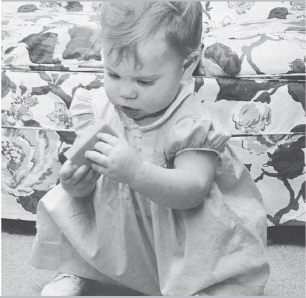
Forget the cute baby in front of the sofa (yes, thats me). Take a gander at that fabulous slipcover fabric and imagine its impact on a 9-foot sofa!
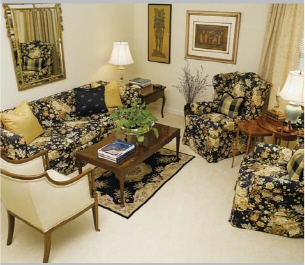
Mrs. Huston made these chair and sofa slipcovers for my parents in the late 70s, and they still look great today. The English floral print came from Calico Corners retail store in St. Louis.
I bought 16 yards of oatmeal-colored kettle cloth and a few more yards of navy velveteen for the welting, and got to work on a new slipcover. Although I had never made a slipcover, I had witnessed many transformations in my parents home, including the excellent work of Mrs. Huston, the seamstress who periodically moved in with her sewing machine and stayed for days (even weeks) constructing new slipcovers when my mother felt like a redo.
How hard can this be? I thought at the time, with the smug confidence of a sewer who began making her clothes in the sixth grade. I quickly realized the truth of this adage: Confidence is what you have before you understand the problem. I charged in with big scissors and made some big mistakes, which sent me back to the fabric store for extra yardage. In the end, my oatmeal slipcover with navy welting looked good enough for a single gals first apartment, and I was able to conceal the really noticeable goofs with pillows and afghans.
If youre a sewer who has the skills, but lacks the confidence to tackle a full-blown slipcover project, you are my reader!
After this first debacle, I read up on slipcovermaking, took a class on the subject, and went on to make many slipcovers during the ensuing years, including two projects featured in national sewing publications. Ive learned through practice, trial and error what works and what doesnt, and have honed some techniques to streamline the construction process. I think Mrs. Huston would approve of my slipcovers today.
Herein lies the nexus of this book. If youre a sewer who has the skills, but lacks the confidence to tackle a full-blown slipcover project,
Next page
